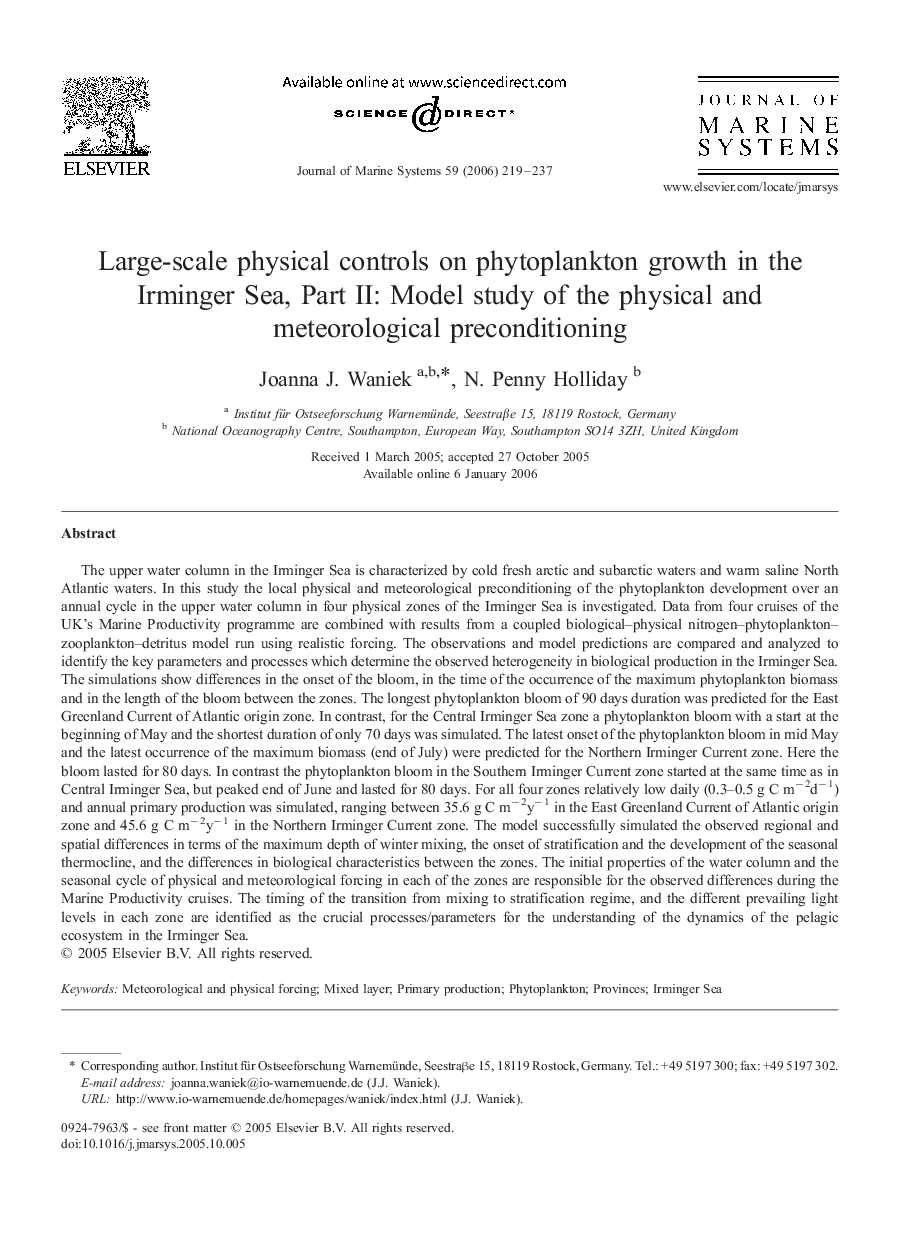| کد مقاله | کد نشریه | سال انتشار | مقاله انگلیسی | نسخه تمام متن |
|---|---|---|---|---|
| 4549485 | 1627368 | 2006 | 19 صفحه PDF | دانلود رایگان |
عنوان انگلیسی مقاله ISI
Large-scale physical controls on phytoplankton growth in the Irminger Sea, Part II: Model study of the physical and meteorological preconditioning
دانلود مقاله + سفارش ترجمه
دانلود مقاله ISI انگلیسی
رایگان برای ایرانیان
کلمات کلیدی
موضوعات مرتبط
مهندسی و علوم پایه
علوم زمین و سیارات
اقیانوس شناسی
پیش نمایش صفحه اول مقاله

چکیده انگلیسی
The upper water column in the Irminger Sea is characterized by cold fresh arctic and subarctic waters and warm saline North Atlantic waters. In this study the local physical and meteorological preconditioning of the phytoplankton development over an annual cycle in the upper water column in four physical zones of the Irminger Sea is investigated. Data from four cruises of the UK's Marine Productivity programme are combined with results from a coupled biological-physical nitrogen-phytoplankton-zooplankton-detritus model run using realistic forcing. The observations and model predictions are compared and analyzed to identify the key parameters and processes which determine the observed heterogeneity in biological production in the Irminger Sea. The simulations show differences in the onset of the bloom, in the time of the occurrence of the maximum phytoplankton biomass and in the length of the bloom between the zones. The longest phytoplankton bloom of 90 days duration was predicted for the East Greenland Current of Atlantic origin zone. In contrast, for the Central Irminger Sea zone a phytoplankton bloom with a start at the beginning of May and the shortest duration of only 70 days was simulated. The latest onset of the phytoplankton bloom in mid May and the latest occurrence of the maximum biomass (end of July) were predicted for the Northern Irminger Current zone. Here the bloom lasted for 80 days. In contrast the phytoplankton bloom in the Southern Irminger Current zone started at the same time as in Central Irminger Sea, but peaked end of June and lasted for 80 days. For all four zones relatively low daily (0.3-0.5 g C mâ 2dâ 1) and annual primary production was simulated, ranging between 35.6 g C mâ 2yâ 1 in the East Greenland Current of Atlantic origin zone and 45.6 g C mâ 2yâ 1 in the Northern Irminger Current zone. The model successfully simulated the observed regional and spatial differences in terms of the maximum depth of winter mixing, the onset of stratification and the development of the seasonal thermocline, and the differences in biological characteristics between the zones. The initial properties of the water column and the seasonal cycle of physical and meteorological forcing in each of the zones are responsible for the observed differences during the Marine Productivity cruises. The timing of the transition from mixing to stratification regime, and the different prevailing light levels in each zone are identified as the crucial processes/parameters for the understanding of the dynamics of the pelagic ecosystem in the Irminger Sea.
ناشر
Database: Elsevier - ScienceDirect (ساینس دایرکت)
Journal: Journal of Marine Systems - Volume 59, Issues 3â4, February 2006, Pages 219-237
Journal: Journal of Marine Systems - Volume 59, Issues 3â4, February 2006, Pages 219-237
نویسندگان
Joanna J. Waniek, N. Penny Holliday,